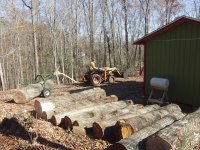My former business partner was a wood combustion guru (designed control systems for commercial wood boilers, designed a high efficiency, clean-burning residential-scale cordwood boiler, sole heat in his super-insulated home is a small wood stove in which he burns 1 cord per year - keeping his 1700 sq ft home at 70+˚ through a Vermont winter). According to him (and he had the scientific data and studies to back it up), burning smaller splits is more efficient than burning large logs - even if they are at equal moisture content.
Of course, efficiency is not always someone's primary goal. Some are more interested in saving labor splitting, or in getting a burn that will last through the night (easier with bigger pieces, which tend to slow the burn rate).
Choking down a fire (starving it for oxygen) to make it last may get you through the night, but it will drop your efficiency to ****, since the gaseous products of combustion will not ignite. A whole lot of BTUs will simply go up the chimney, unburned (or deposit on the walls of your flue as creosote).








